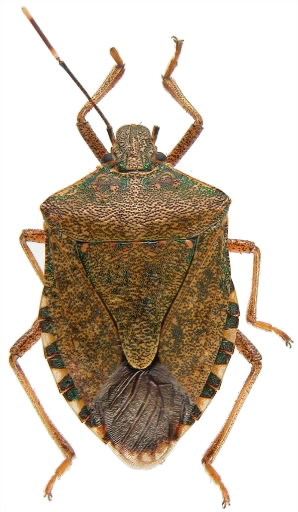Stink Bugs:
 During the winter months, adult stink bugs are found in protected areas such as ditch banks, fence rows, under boards and dead weeds, ground cover, stones, and under the bark of trees. Brown stink bugs often feed on the vegetative plants, flowers, stems and foliage of the plant, as well as the seed, nut or fruit, and are found on a variety of hosts, such as shrubs, vines, many broadleaf weeds, especially legumes, as well as cultivated crops such as corn, soybean, sorghum, okra, millet, snap beans, peas and cotton. Brown stink bugs are dull brownish- yellow in color and 12 - 15 mm long. Their white or pale green barrel-shaped eggs are laid in clusters on the undersides of leaves. Egg masses have about 25 eggs that are only about 1 mm in diameter but become apparent when nymphs have emerged, as they will stay at the egg mass for several days. As with all immature stink bugs, the nymphs lack fully developed wings and have been described as tick-like in appearance, ranging in size from 2.4 mm (1st instar) to 12 mm (5th instar). Nymphs need to molt, or shed their outer skin (exoskeleton), as they progress through five different stages or nymphal instars. First instars are colored orange or red and remain clustered around the egg mass, sometimes until they molt to the 2nd instar stage. The 2nd instar begins to develop an almost black appearance, and subsequent instars (3rd, 4th, and 5th) begin to acquire more of the adult coloration.
During the winter months, adult stink bugs are found in protected areas such as ditch banks, fence rows, under boards and dead weeds, ground cover, stones, and under the bark of trees. Brown stink bugs often feed on the vegetative plants, flowers, stems and foliage of the plant, as well as the seed, nut or fruit, and are found on a variety of hosts, such as shrubs, vines, many broadleaf weeds, especially legumes, as well as cultivated crops such as corn, soybean, sorghum, okra, millet, snap beans, peas and cotton. Brown stink bugs are dull brownish- yellow in color and 12 - 15 mm long. Their white or pale green barrel-shaped eggs are laid in clusters on the undersides of leaves. Egg masses have about 25 eggs that are only about 1 mm in diameter but become apparent when nymphs have emerged, as they will stay at the egg mass for several days. As with all immature stink bugs, the nymphs lack fully developed wings and have been described as tick-like in appearance, ranging in size from 2.4 mm (1st instar) to 12 mm (5th instar). Nymphs need to molt, or shed their outer skin (exoskeleton), as they progress through five different stages or nymphal instars. First instars are colored orange or red and remain clustered around the egg mass, sometimes until they molt to the 2nd instar stage. The 2nd instar begins to develop an almost black appearance, and subsequent instars (3rd, 4th, and 5th) begin to acquire more of the adult coloration.
Adults are approximately 1/2 inch long, and have a mottled appearance. Alternating dark and light bands occur on the last two antennal segment. Additionally, the head and pronotum are covered with patches of coppery or bluish metallic-colored punctures and the margins of the pronotum are smooth as compared to the toothed, jagged pronotal margin of Brochymena . The exposed lateral margins of the abdomen are marked with alternate bands of brown and white. Faint white bands are also evident on the legs. The adults mate in the spring approximately two weeks after emerging from diapause or the resting phase. After a short period, the females begin laying egg masses. Egg masses are laid at approximately weekly intervals, and each female lays as many as 400 eggs in her lifetime. First instar nymphs emerge four to five days after eggs are laid. Nymphs are solitary feeders, but they occasionally aggregate between overlapping leaves or leaf folds,and each stage lasts approximately one week, depending upon temperature. Laboratory studies indicate that adults are sexually mature two weeks after their final molt Adults are very active and drop from plants or fly when disturbed. Adults will enter homes and other buildings when seeking sheltered sites to overwinter, or diapause. During the several weeks of peak flight, many insects can enter homes through any small opening, mostly around windows.

